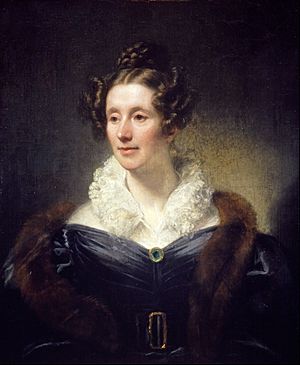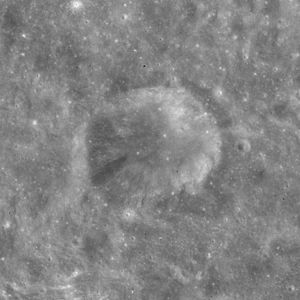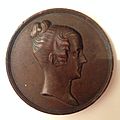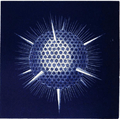Mary Somerville facts for kids
Mary Somerville was a Scottish writer who explained science to many people. She was also a polymath, meaning she knew a lot about many different subjects. Mary Somerville was also famous for supporting more education and civil rights for women.
Contents
Early Life and Learning
Mary Somerville was born on December 26, 1780, in Jedburgh, Scotland. She was one of seven children, but only three of them lived to become adults. Her father, William George Fairfax, was a vice-admiral in the Royal Navy. He was often away on long trips.
Mary's mother did not try to teach her daughters to read or write. She believed girls only needed to learn how to cook and clean. When Mary was not doing chores, she loved to explore the seaside and the moors.
When Mary's father came home, he found that his ten-year-old daughter could not read or write. He sent her to a boarding school. As a teenager, Mary became very interested in algebra. Her parents were upset by this. They told her not to study math. They worried it would harm her body and mind.
Marriage and Studies
In 1804, when she was 24, Mary married Samuel Grieg. She found that marriage gave her more freedom from her parents. She began to study algebra. She had two sons, but her husband died in 1807. As a widow, she had even more freedom to study. She learned many more mathematical ideas.
In 1812, she married again. Her second husband was William Somerville. They had four children together. With William's support, Mary began to do experiments. She studied the effects of solar radiation (sunlight) on different things on Earth.
Her Important Work
Mary Somerville studied how the sun's rays affected different materials on Earth. In 1826, she published her first scientific paper. It was called "On The Magnetizing Power of the More Refrangible Solar Rays."
Later, she published two more papers and two books. She then moved to Italy and started her third book. In 1848, she published a book called Physical Geography.
Awards and Recognition
Mary Somerville wrote many important books. Her second book helped lead to the discovery of the planet Neptune. Because of her work, she became one of the first two women to be named Honorary members of the Royal Astronomical Society.
Mary Somerville also had her picture hung in the Royal Society's great hall. In 1870, she won the Victoria Gold Medal from the Royal Geographic Society. This was a very high honor.
Later Life and Legacy
In 1860, Mary's only son who was still alive passed away. Her husband died five years later. Mary became very sad. Her daughter encouraged her to keep writing. She did, but she was not as connected to the newest scientific ideas.
Mary began to work for civil rights and better education for women. She died at age 92 in Naples, Italy, on November 19, 1872. Oxford University later named one of its colleges after her.
After Mary Somerville died, her autobiography was published. It was called Personal Recollections. It contained her memories from her early life to old age.
Over 10,000 items are kept in the Somerville Collection. This collection is at the Bodleian Library and Somerville College in Oxford. It includes her writings, published works, and letters. She wrote to family, many scientists, writers, and other important people. She also exchanged many letters with the Byron and Lovelace families.
Many places and things have been named after Mary Somerville or her family.
- Somerville Square in Burntisland, Scotland, is named after her family.
- Somerville College, Oxford, was named after her.
- Somerville House in Burntisland, where she lived, is also named after her.
- Somerville House, a high school for girls in Brisbane, Australia, carries her name.
- One of the meeting rooms in the Scottish Parliament in Edinburgh is named after her.
- Somerville Island, a small island in Barrow Strait, Nunavut, was named after her in 1819.
- An asteroid called 5771 Somerville (1987 ST1) was named after her.
- Somerville crater is a small crater on the Moon. It is one of the few lunar craters named after women.
In 2016, the Royal Bank of Scotland held a public vote. People chose whose face should appear on the new £10 banknotes. Mary Somerville won the vote. Her image appeared on the banknotes issued in 2017.
On February 2, 2020, Google honored her with a special Google Doodle.
Her Published Works
- 1826 On the magnetizing power of the more refrangible solar rays
- 1831 Mechanism of the Heavens
- 1832 A Preliminary Dissertation on the Mechanisms of the Heavens
- 1834 On the Connection of the Physical Sciences
- 1848 Physical Geography
- 1869 Molecular and Microscopic Science
- 1874 Personal recollections, from early life to old age, of Mary Somerville
Images for kids
-
View of the City of Edinburgh by Alexander Nasmyth. Mary spent the winters in Edinburgh and attended Nasmyth's academy.
-
Page 157 from Mechanism of the Heavens, Somerville discusses the law of universal gravity and Kepler's laws of planetary motion.
-
In the revised third edition of Physical Geography, published in 1851, Somerville noted that her publisher had intended to include illustrations, but that this plan was abandoned since the Physical Atlas provided maps illustrating the "most important questions" of physical geography. Geographical Distribution of Plants from Alexander Keith Johnston's 1848 The Physical Atlas.
-
One of the 180 illustrations in the book Molecular and Microscopic Science, published 1869. This is an illustration of an Haliomma Echinaster, a marine phosphorescence.
See also
 In Spanish: Mary Somerville para niños
In Spanish: Mary Somerville para niños












